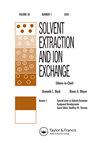中空纤维膜接触器同时去除水溶液中铜(II)和锌的CFD分析
IF 2.1
4区 化学
Q3 CHEMISTRY, MULTIDISCIPLINARY
引用次数: 1
摘要
摘要本研究是一种在中空纤维膜接触器(HFMC)中使用一种名为三氟乙酰丙酮的高效溶剂进行液-液萃取铜(II)和锌的新方法。为了分析提取过程并了解其潜在机制,采用了计算流体动力学(CFD)。通过耦合质量和动量方程,在三个域中进行萃取,以表达溶质在中空纤维膜接触器中通过膜从管侧到壳侧的传输。有限元方法模拟了控制方程,并验证了结果。本工作旨在通过模拟获得铜(II)和锌的分布。研究了一些关键参数的影响。结果表明,提高分配系数和降低管侧流量可以提高萃取效率。此外,温度显著影响萃取,通过将温度从298 K提高到313 K,铜(II)的效率提高了12%,锌的效率增加了6.6%。此外,发现膜孔隙率是另一个有影响的参数。通过将膜孔隙率提高25%至90%,铜(II)的效率提高至95%,锌的效率提高到98%。本文章由计算机程序翻译,如有差异,请以英文原文为准。
CFD Analysis of Simultaneous Removal of Copper (II) and Zinc from Aqueous Solution Using a Hollow Fiber Membrane Contactor
ABSTRACT The current study is a new method for liquid–liquid extraction of copper (II) and zinc that was carried out using an efficient solvent called trifluoroacetylacetone in a hollow fiber membrane contactor (HFMC). To analyze the extraction process and understand its underlying mechanisms, computational fluid dynamics (CFD) was employed. The extraction was performed in three domains by coupling the mass and momentum equation to express the solute transport from the tube side to the shell side through the membrane in a hollow fiber membrane contactor. The finite element approach simulates the governing equation and validates the results. This work aims to obtain the distribution of copper (II) and zinc by performing a simulation. The effect of some crucial parameters was investigated. The results illustrate that the extraction efficiency increases by increasing the partition coefficient and decreasing the flow rate on the tube side. Also, the temperature significantly affects extraction, and by enhancing the temperature from 298 to 313 K, the efficiency increases by 12% for copper (II) and 6.6% for zinc. Furthermore, the membrane porosity was found to be another influential parameter. By increasing the membrane porosity of 25% to 90%, the efficiency increases to 95% for copper (II) and 98% for zinc.
求助全文
通过发布文献求助,成功后即可免费获取论文全文。
去求助
来源期刊
CiteScore
4.40
自引率
5.00%
发文量
15
审稿时长
8.4 months
期刊介绍:
Solvent Extraction and Ion Exchange is an international journal that publishes original research papers, reviews, and notes that address all aspects of solvent extraction, ion exchange, and closely related methods involving, for example, liquid membranes, extraction chromatography, supercritical fluids, ionic liquids, microfluidics, and adsorption. We welcome submissions that look at: The underlying principles in solvent extraction and ion exchange; Solvent extraction and ion exchange process development; New materials or reagents, their syntheses and properties; Computational methods of molecular design and simulation; Advances in equipment, fluid dynamics, and engineering; Interfacial phenomena, kinetics, and coalescence; Spectroscopic and diffraction analysis of structure and dynamics; Host-guest chemistry, ion receptors, and molecular recognition.

 求助内容:
求助内容: 应助结果提醒方式:
应助结果提醒方式:


